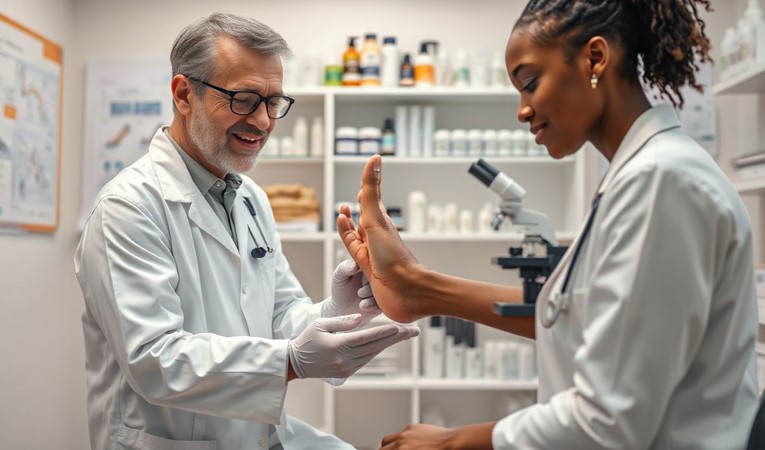
Athlete's Foot Doctor: Your Essential Guide To Diagnosis, Treatment, And Prevention
Read Count : 129
Category : Blogs
Sub Category : Miscellaneous
Athlete’s foot, also known as tinea pedis, is one of the most common fungal infections worldwide. It affects millions, especially those who spend a lot of time on their feet or in humid environments. Visiting a healthcare professional for proper diagnosis and treatment can make a big difference. Acting quickly helps prevent the infection from spreading and causing more serious problems. Recognizing symptoms early and seeing a doctor ensures you get the right care. What Is Athlete’s Foot? Understanding the Basics Definition and Overview Athlete’s foot is caused by a fungi called dermatophytes. These tiny organisms thrive in warm, moist places like sweaty shoes or public showers. It’s a common skin infection, especially among athletes, swimmers, and people living in hot, humid climates. While anyone can get it, those with damp feet or poor hygiene are more at risk. Symptoms and Signs The signs of athlete’s foot usually include: • Itching and burning between toes or on soles • Cracking, peeling, or peeling skin • Red, irritated rash • Sometimes blisters or raw skin Everyone experiences it differently; some have mild discomfort, while others face painful, spreading rashes. Risk Factors Certain habits and environments boost your chances of catching athlete’s foot: • Wearing sweaty shoes or socks all day • Using communal showers, gyms, or swimming pools without protection • Having a weakened immune system • Poor foot hygiene or not drying feet properly • Sharing shoes or towels with others Why Visiting an Athlete’s Foot Doctor Is Essential Accurate Diagnosis It’s tempting to treat athlete’s foot at home, but a doctor’s opinion matters. Symptoms can look alike to other skin issues, like eczema or psoriasis. A healthcare professional can tell the difference and avoid wrong treatments. They usually check your skin and might perform simple tests for confirmation. Personalized Treatment Plans Not all athlete’s foot cases are the same. Some need a quick over-the-counter remedy, others require stronger prescription meds. A doctor considers your overall health, how bad the infection is, and other factors before suggesting a plan. Preventing Complications If left untreated, athlete’s foot can lead to more serious issues. It may cause bacterial infections or spread to other parts of your body. It can also be contagious to family members and friends. Visiting a doctor reduces these risks and helps you recover faster. How Athlete’s Foot Is Diagnosed by a Medical Professional Clinical Examination During your visit, the doctor looks carefully at your feet, noting the rash’s location, texture, and appearance. They check for signs of infection or other skin problems. Laboratory Tests Sometimes, they may take a small skin sample for lab testing. A quick test called KOH microscopy helps spot fungi under a microscope. Cultures can also grow the fungi, confirming the diagnosis. These tests guide more effective treatment choices. When to Seek Medical Advice If your symptoms don’t improve after a week of home treatment, or if they worsen, see a healthcare provider. Also, if the rash starts spreading or causes pain, it’s time to get expert help. Treatment Options Provided by an Athlete’s Foot Doctor Topical Antifungal Medications Common treatments include creams, sprays, or powders. Options like clotrimazole or terbinafine are popular. Applying these medications exactly as instructed and for the full recommended time kills the fungi and stops the infection from returning. Oral Antifungal Medications Severe or stubborn cases might need pills. These help treat infection from the inside out but come with potential side effects. Your doctor will monitor your health during this process to ensure safety. Additional Therapies Some clinics offer laser therapy to kill fungi directly. Using medicated powders and sprays helps keep your feet dry and prevent re-infection. During treatment, good hygiene and moisture control are key. Preventing Athlete’s Foot: Expert Recommendations Hygiene and Foot Care Wash your feet daily with soap and water. Make sure to dry thoroughly, especially between the toes. Keeping your feet clean reduces fungi buildup. Proper Footwear Choose socks made from moisture-wicking material. Avoid tight shoes or those that don’t breathe. Regularly clean and air out your shoes to keep fungi away. Environmental Precautions Wear flip-flops or shower shoes in communal showers and pools to avoid contact with fungi on shared surfaces. Using antifungal powders or sprays in shoes adds extra protection. Lifestyle Modifications Eat a balanced diet, stay active, and manage stress to boost your immune health. These habits make it easier for your body to fight off infections. Regular check-ups help catch problems early if you often struggle with athlete’s foot. Follow-up and Monitoring If you’re prone to recurring infections, see your doctor regularly. They can help you develop routines that keep athlete’s foot at bay and treat any flare-ups promptly. When to Seek Immediate Medical Attention Seek urgent care if you notice: • Signs of bacterial infection like swelling, pus, or increasing redness • Wide spread or worsening rash despite treatment • Fever or severe pain • Cracks or open sores that won’t heal Failing to get timely treatment can lead to complications and longer recovery times. Seeing an athlete’s foot doctor is critical for proper diagnosis and effective treatment. Early intervention helps you recover faster and avoids spreading infection. Keep your feet dry, practice good hygiene, and follow medical advice to prevent future problems. If you notice symptoms, don’t wait — consult a healthcare professional right away. This simple step protects your health and keeps your feet happy and healthy.
Comments
- No Comments

